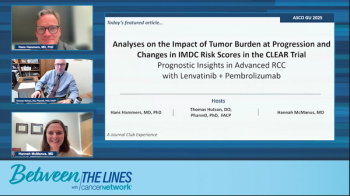
Future research will aim to assess the efficacy of PIPAC-MMC plus systemic therapy vs systemic therapy alone in patients with peritoneal tumors.

Your AI-Trained Oncology Knowledge Connection!


Future research will aim to assess the efficacy of PIPAC-MMC plus systemic therapy vs systemic therapy alone in patients with peritoneal tumors.

“Recognizing that we could follow immunotherapy with a bone marrow transplant safely was quite important,” Nina Wagner-Johnston, MD, stated.

Although small incision surgery may serve as a conduit to deliver PIPAC-MMC, it may confer benefits in the staging and treatment of peritoneal tumors.

Patients with peritoneal metastases were historically associated with limited survival and low consideration for clinical trials.

Greater cancer treatment longevity enables oncologists the ability to form more impactful relationships with their patients.

A recent Oncology Decoded podcast focuses on adjuvant therapy like pembrolizumab and optimal post-surgical care for patients with kidney cancer.

Panelists discuss how second-line treatments for gastric adenocarcinoma provide survival advantages, improved quality of life, and opportunities for personalized therapy based on molecular profiling and prior treatment response.

Panelists discuss how multidisciplinary strategies incorporating chemotherapy, targeted agents, and immunotherapy are strategically sequenced to optimize outcomes for patients with advanced metastatic gastric adenocarcinoma.

Panelists discuss how multidisciplinary approaches, molecular profiling, and recent advances in targeted therapies and immunotherapy have transformed the management landscape for patients with metastatic gastric adenocarcinoma.

Panelists discuss how they incorporate nivolumab into clinical practice, highlighting specific patient characteristics, biomarkers, and disease features that predict favorable responses to this immunotherapy agent.

Panelists discuss how recent clinical trials have revolutionized treatment paradigms for gastrointestinal cancers, shaping evidence-based approaches that optimize patient outcomes through targeted therapies, immunotherapies, and multimodal treatment strategies.

Panelists discuss how the BESPOKE study’s innovative design, carefully selected efficacy end points, and rigorous methodological approach aim to evaluate personalized therapeutic interventions with unprecedented precision.

Panelists discuss how circulating tumor DNA (ctDNA) serves as a promising biomarker for early detection, treatment monitoring, and recurrence surveillance in patients with colorectal cancer (CRC).

Panelists discuss that when selecting a chimeric antigen receptor T-cell (CAR T) product for a patient with an aggressive clinical course and eligibility for cellular therapy, key considerations include urgency, toxicity risks, and efficacy. Factors such as time to manufacture, cytokine release syndrome/immune effector cell–associated neurotoxicity syndrome rates, long-term remission data, and antigen specificity guide decision-making.

Panelists discuss how PSMA PET imaging utilizes various tracers, each with distinct properties influencing image quality and diagnostic accuracy. Fluciclovine F18 (Axumin) is primarily used for detecting recurrent prostate cancer, offering moderate sensitivity but lower specificity compared with PSMA-targeted agents. Gallium Ga 68 gozetotide (Illuccix) provides high sensitivity and specificity for prostate cancer lesions; however, its shorter half-life and limited availability may restrict widespread use. Piflufolastat F18 (Pylarify) combines the benefits of F18’s longer half-life with high image resolution, enhancing detection accuracy. Similarly, flotufolastat F18 (Posluma) leverages F18’s favorable imaging characteristics, offering high-quality images and reliable lesion detection.

Experts discuss the KEYMAKER-U03 trial, highlighting lenvatinib plus belzutifan as a promising option in advanced renal cell carcinoma and new directions emerging from the 2025 American Society of Clinical Oncology Genitourinary Cancers Symposium.

Panelists discuss how, when selecting among chimeric antigen receptor T-cell (CAR T) therapies, medical professionals typically consider several key factors: the specific cancer type and its CD19/BCMA expression, FDA-approved indications for each therapy, the patient’s prior treatments and response history, the therapy’s documented efficacy and safety profile, manufacturing time and availability, and center-specific experience with different products. Patient-specific factors like comorbidities and disease burden also influence the decision.

Experts discuss their approaches to first-line renal cell carcinoma treatment selection, comparing immunotherapy (IO)-IO vs IO-tyrosine kinase inhibitor strategies.

Panelists discuss how prospective randomized data, notably from Hofman et al (Lancet, 2020), demonstrate that PSMA PET-CT exhibits superior diagnostic accuracy compared with conventional imaging in detecting pelvic nodal and distant metastases in patients with high-risk prostate cancer. Conventional imaging techniques, such as CT and bone scans, often have lower sensitivity and specificity, potentially missing smaller or early metastatic lesions. In contrast, PSMA PET-CT offers enhanced sensitivity and specificity, leading to more precise staging and management decisions.

Adaptive radiation may help individualize therapy based on transient factors patients are faced with while receiving treatment for cancer.

Experts from Sibley Memorial Hospital highlight radiation oncology technologies that have played key roles in cancer care at their institution.

Future work may focus on determining strategies for protecting the health of patients who undergo surgery during climate disasters.

“We see that those taking chemotherapy are going to be the ones that are going to require the most help,” Clara Bodelon, PhD, MS, said regarding breast cancer treatment.

“[There] is a need to make sure that everybody is coming in and bringing their expertise together,” Valerie Lee, MD, said.

Collaboration among different medical and research institutions may help improve quality of care for patients with cancer exposed to climate disasters.

Experts discuss how, it is crucial to approach treatment strategies with both compassion and transparency. It is important to explain the complexity of the situation and maintain clear and accessible language when discussing treatment strategies with patients and their families.

Experts discuss how, there is a role for SRS in treating brain metastases such as if a patient were to have a large singular brain metastasis that is causing symptoms such as seizures of neurological decline, that SRS could be a warranted treatment.

Experts discuss specific biomarkers or clinical features that would prompt earlier consideration of trastuzumab deruxtecan or other HER2-directed therapies.

Experts discuss the factors supporting the choice of trastuzumab deruxtecan following disease progression and its mechanism of action in addressing resistance to prior HER2-targeted therapy and provide insights on the updated analysis from the DESTINY-Gastric02 Trial.

Patients with breast cancer who were treated with chemotherapy may have more pain, fatigue, and difficulty moving vs those who received endocrine therapy or did not have breast cancer.